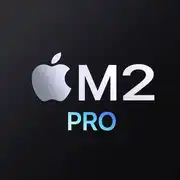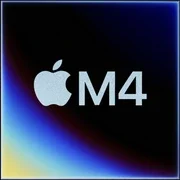Apple M2 Pro

Apple M2 Pro: Power and Efficiency in Every Inch
March 2025
Five years have passed since the release of the first Apple Silicon chips, and the M series processors continue to set new standards for performance and energy efficiency. In 2025, the Apple M2 Pro remains a key player in the professional laptop segment, combining innovative architecture with impressive battery life. Let's explore what makes this processor noteworthy and who it is suited for.
Architecture and Process Technology: 5 nm, 12 Cores, and Revolutionary Integration
The Apple M2 Pro is built on a 5-nanometer process technology, allowing for 40 billion transistors to be placed on the chip. This enables high computational density with minimal energy consumption.
Cores and Threads
- 12 Cores: 8 high-performance (Performance-cores) and 4 energy-efficient (Efficiency-cores).
- 12 Threads: Unlike Intel and AMD, Apple does not use Hyper-Threading. Each core handles one thread, but thanks to the optimization of macOS and Apple's own task scheduler, high parallel performance is achieved.
- Frequencies: Base frequency for P-cores is 3.5 GHz, and in turbo mode, it goes up to 4.2 GHz. E-cores run at 2.4 GHz, saving battery life.
Integrated Graphics
The built-in GPU of the Apple M2 Pro has 19 cores, which is 20% more powerful than that of the M1 Pro. It supports:
- Simultaneous use of two 6K monitors (Pro Display XDR).
- Hardware acceleration for video encoding/decoding (ProRes, H.265).
- 3D model editing in applications like Blender and Cinema 4D.
Power Consumption and TDP: 35 W for Balance
The Thermal Design Power (TDP) of the Apple M2 Pro is 35 W, which is significantly lower than its competitors (e.g., Intel Core i9-14900H — 45-65 W). This has been made possible due to:
- Architecture Optimization: The division into P- and E-cores allows tasks to be distributed so that power-hungry cores only activate under peak loads.
- Unified Memory: A shared memory system for the CPU and GPU reduces latency and energy costs associated with data transfer.
Even under maximum load, the cooling system of the MacBook Pro 16" (2025) handles operations without throttling, keeping temperatures below 85°C.
Performance: Faster than Ever
Synthetic Benchmarks
- Geekbench 6: 2626 (Single-Core), 13597 (Multi-Core). For comparison, Intel Core i9-14900H scores ~2400/12500, and AMD Ryzen 9 8940HS scores ~2300/13200.
- Cinebench R23: 1850 (Single-Core), 15800 (Multi-Core).
Real-World Tasks
- Office Work: Simultaneous handling of 50+ tabs in Chrome, Excel spreadsheets with millions of rows, and Zoom conferences without slowdowns.
- Multimedia: 8K video rendering in Final Cut Pro is 30% faster than on M1 Pro.
- Gaming: In Resident Evil Village (Medium settings, 1920x1200) — stable 45-50 FPS. However, for AAA games at 4K, an external GPU (like an eGPU with AMD Radeon RX 7700 XT) will be necessary.
Turbo mode automatically activates under load, but in the MacBook Pro 16", it lasts longer than in the 14-inch model due to an improved cooling system.
Use Cases: Who is the M2 Pro For?
1. Professionals:
- Video editors, 3D designers, programmers (especially for iOS/macOS).
- Example: Building a project in Xcode takes 15% less time than on M1 Pro.
2. Creative Users:
- Photographers (RAW processing in Lightroom), musicians (recording in Logic Pro).
3. General Tasks:
- Streaming, document work, web surfing.
For gamers, the M2 Pro is a compromise: it will handle indie games and older titles but won't replace a gaming PC.
Battery Life: Up to 18 Hours without Plugging In
The MacBook Pro 16" (2025) with M2 Pro offers:
- 18 hours of web surfing (compared to 12-14 hours on Dell XPS 15 with Intel Core i7).
- 10 hours of video rendering.
Energy-saving Technologies:
- Adaptive Clocking: Dynamic adjustment of core frequency based on load.
- Collaborative CPU and GPU Work: For instance, when editing photos in Photoshop, the GPU processes filters while the CPU manages layers, reducing overall energy consumption.
Comparison with Competitors
Apple M2 Pro vs. AMD Ryzen 9 8940HS
- Performance: M2 Pro excels in single-threaded tasks (+10%), while Ryzen 9 is better in multi-threaded tasks (+5%).
- Power Consumption: Under the same load, Ryzen 9 consumes 20% more energy.
- Price: Laptops with Ryzen 9 are cheaper ($1500-$1800 vs. $1999 for MacBook Pro 14").
Apple M2 Pro vs. Intel Core i9-14900H
- Intel performs better in games and compatibility with Windows applications but lags in battery life (up to 7 hours on ASUS ZenBook Pro 16).
Apple Generations
- The M2 Pro is 25% faster than the M1 Pro and 40% more energy efficient.
Pros and Cons
Strengths:
- Best-in-class battery life.
- High performance in professional applications.
- Silent operation (fans rarely activate).
Weaknesses:
- Limited upgrade options (memory and SSD are soldered to the motherboard).
- High price: MacBook Pro 14" with M2 Pro starts at $1999.
Laptop Selection Recommendations
1. Types of Devices:
- Workstation: MacBook Pro 16" (best cooling, Liquid Retina XDR display).
- Ultra-portable option: MacBook Pro 14" (weighs 1.6 kg, supports two external monitors).
2. Things to Watch For:
- RAM: Minimum of 16 GB for video editing, 32 GB for 3D rendering.
- SSD: 1 TB and above if you're working with large files.
Final Conclusion
The Apple M2 Pro is the ideal choice for those needing mobility without sacrificing performance. It suits:
- Professionals in creative industries.
- Users valuing battery life (up to 18 hours).
- Those already working within the Apple ecosystem (integration with iPhone, iPad, AirPods).
Key Benefits: Power in a compact form factor, quiet operation, long lifespan (5+ years thanks to macOS updates). If your budget allows for an investment of $2000 or more, the M2 Pro will be a reliable tool for years to come.
Basic
CPU Specifications
Memory Specifications
GPU Specifications
Benchmarks
Compared to Other CPU
Related CPU Comparisons
Share in social media
Or Link To Us
<a href="https://cputronic.com/cpu/apple-m2-pro" target="_blank">Apple M2 Pro</a>

